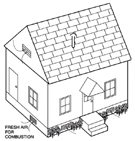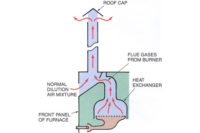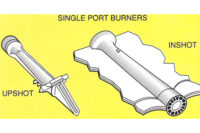With the winter season beginning, equipment problems were starting to surface. The dispatcher called and told Bob that yet another person is describing an unusual smell when the furnace runs for a long period of time.
Bob arrived and talked to the homeowner and the homeowner said to Bob, “The furnace has been running off and on for several days with no problems. This morning, the furnace ran for a long time and an odor seemed to be coming from it.”
Bob went to the furnace room and the furnace was running. He could smell the aldehydes in the area. He knows that products of combustion contain aldehydes that are not poisonous, but are present in combustion gases.
He went to the truck and got a candle that he uses to see if the furnace draft is working. The furnace is backdrafting slightly.
Bob was scratching his head when Btu Buddy showed up. Bob said, “It is good to see you. You always seem to appear when I have a problem.”

Figure 1. This illustration shows how the combustion air and dilution air reach this standard efficiency furnace. (Figures are from Practical Heating Technology by William Johnson, published by Delmar Cengage Learning.)
Bob responded, “I think I will examine the flue to see if it is in good shape. I found a bird’s nest in one the other day.”
Bob got a ladder and climbed to the top of the house and removed the flue cap. The flue cap is built so that no bird can make a nest in it, but he removed it anyway. He could see that there was no obstruction by looking down the flue with a flashlight. He went down to the furnace room and examined the actual flue connected to the furnace. It was double-wall pipe like it should be. The flue system looked good. He then asked Btu Buddy, “What do you think?”
Btu Buddy then said, “I see the problem, but I want you to look around a little longer before I tell you and see if you figure it out.”
Bob looked around again. When the furnace started drafting like it should, the furnace room door was open to the rest of the house. After a few minutes, Btu Buddy said, “Close the door to the room and see what happens.”
Bob closed the door and, within a few minutes, the furnace stopped drafting again. Bob looked around and discovered a rug covering a floor grille in front of the furnace. When he removed the rug, a flow of cool air came into the room and the furnace started drafting (Figure 1). Btu Buddy said, “That was the problem. Somebody came into the room and felt the draft and covered the fresh air intake to the room, called makeup air. It must be left unobstructed for the furnace to operate correctly.”

Figure 2. This illustration shows the combustion air requirements for perfect combustion.
“But that isn’t the end of the story. Perfect combustion is for laboratory studies and is not practical for field equipment. Practical combustion and the regulations call for excess air to be furnished to the combustion process. Typically 50 percent excess air is used. So, the furnace must be furnished with 15 cubic feet of air for each cubic foot of gas or 1,000 Btu of input for natural gas. In addition to the 50 percent air for combustion, another 10 cubic feet of air and 50 percent excess air must be provided for dilution air for the venting process (Figure 4). This other 50 percent goes up the draft diverter on standard furnaces to carry the products of combustion up the flue. Other gases, such as propane, have tables for calculating air for them.”
Bob exclaimed, “There sure is a lot to this. Who is supposed to do all of this calculating?”

Figure 3. There is 1 cubic foot of oxygen for every 5 cubic feet of air.
Bob then asked, “How do you know what size of grille is the right size?”
Btu Buddy answered, “There are rules of thumb used for sizing and checking jobs in the field. The makeup air for the house we are in must come from two places. It is a one-story house built on a crawl space with an attic and the combustion air sources are easy to deal with. There must be air for the burner that comes from near the floor and air for venting that comes from up high. In this case, the burner air comes from the grille that was covered and the air for venting comes from that vent that is in the ceiling that you haven’t mentioned.”
Bob looked up and said, “I could feel a breeze, but did not notice where it came from and it is part of the system. These two grilles are about the same size. How should I check them for the correct size?”
Btu Buddy said, “The National Fuel Gas Code calls for 1 square inch of free area for the dilution air and 1 square inch free area for the combustion air for each 1,000 Btu per hour of input of the furnace. This is a 60,000 Btuh output furnace and it is of the 80 percent efficiency type, natural draft with a draft diverter, so it is a 75,000 Btuh input furnace (60,000/0.80 = 75,000 input). There should be two grilles that each has a free area of 75 square inches.”

Figure 4. This is an illustration of burning 1 cubic foot of gas in a standard gas furnace.
Btu Buddy then said, “Imagine that a 12-inch x 12-inch grille has an area of 144 square inches (12 x 12 = 144). That is grille area, but there are louvers inside the grille that take up room that obstruct the flow, or take up area. Most technicians multiply the actual area by 0.70 (for 70 percent) to calculate the usable or free area. So the 144 square inch grille would provide 100.8 square inches of free area (144 x 0.70 = 100.8).”
Bob then asked, “OK, how do we calculate the grille sizes for this furnace?”
Btu Buddy said, “Let’s use 12 inches for one side of the grille and calculate the other side. One reason to use 12 inches is that it will fit between rafters for the ceiling and floor joists that are in the floor. For larger furnaces, you can use 14 inches. The rafters and floor joists are on 16-inch centers, so a 14-inch grille will go between. The formula is X = Furnace input in cubic feet per hour/common side x 0.70 where:
• X = the side we want to know
• Furnace input in Btuh/1,000 Btu/cubic foot = cubic feet per hour
• common side = 12 inches
• multiplied by 0.70 for free area calculation percentage
X = 75 cubic feet/12 inches x 0.70
X = 8.93 inches
A 10-inch x 12-inch grille is a standard size and will fit great and have some excess capacity.”
Bob said, “Boy, that is a lot to remember. Is there more?”

Figure 5. This shows a structure that is like the structure in the article.
Bob then asked, “Have these codes always been in force? I have seen many houses that I am sure did not have any combustion air or dilution air vents.”
Btu Buddy then explained, “The codes have come about since the early 1970s in many localities. That was the time of the first energy shortage. Until then, homes were not constructed as tight as they are today. The windows and cracks around the structures allowed infiltration air that was adequate for combustion air needs. With the energy shortage, energy prices started going up and people began to tighten down houses with storm windows and doors. Construction codes started calling for tighter homes and then there was a need to furnish planned, fixed ventilation for combustion air needs. Now is the time to talk to the homeowner and explain that these vents must not be covered for any reason.”
Bob went and talked to the homeowner and explained the situation. All was well now.
While riding away, Bob said, “There sure seems to be a lot of air coming into that house for combustion, even though it is necessary. Is there no other way?”
Btu Buddy then said, “Great question. Many of the new furnaces have the combustion air pulled in through a pipe and exhausted through another pipe. The furnace and venting system becomes a system that can be much more efficient than the natural draft system in this house, but also much more expensive. They have a combustion blower to create the movement of combustion gases, rather than the heat rises system of this furnace.”
Bob then said, “We are getting this one step at a time. Thanks for the help.”
Publication date:01/21/2008









